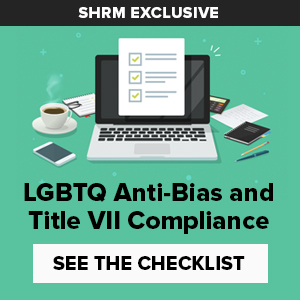
Many employers already have policies and practices in place that are inclusive of lesbian, gay, bisexual, transgender and queer (LGBTQ) workers, and now is a good time to review those programs in light of the U.S. Supreme Court’s ruling that LGBTQ workers are protected by federal employment anti-discrimination law.
In a 6-3 ruling on June 15, the high court said that an employer who fires a worker merely for being gay or transgender violates Title VII of the Civil Rights Act of 1964.
“Although this ruling was widely anticipated, many state and local laws already prohibit discrimination based on sexual orientation and gender identity,” said David Ritter, an attorney with Barnes & Thornburg in Chicago.
Those existing state and local laws that explicitly protect applicants and employees from discrimination based on sexual orientation and gender identity will remain in place, explained Chai Feldblum, an attorney with Morgan Lewis in Washington, D.C., and former commissioner of the Equal Employment Opportunity Commission. The Supreme Court decision now protects LGBTQ workers nationwide.
Even before the Supreme Court ruling, employers for a large segment of the workforce already adopted LGBTQ-inclusive polices, observed Adam Sencenbaugh, an attorney with Haynes and Boone in Austin, Texas. “But for those who haven’t, now is the time to do it.”
Anti-Discrimination Policies
 “As a practical matter for all the companies that already have anti-discrimination and anti-harassment policies for LGBTQ+ people, this is simply an affirmation of their existing policies,” Feldblum said. “Employers that had not previously prohibited discrimination on the basis of sexual orientation and gender identity should obviously do so now in their various policy documents.”
“As a practical matter for all the companies that already have anti-discrimination and anti-harassment policies for LGBTQ+ people, this is simply an affirmation of their existing policies,” Feldblum said. “Employers that had not previously prohibited discrimination on the basis of sexual orientation and gender identity should obviously do so now in their various policy documents.”
Those employers can make clear that they understand that the prohibition against sex discrimination, which they have been complying with for years, also includes a prohibition against discrimination on the basis of sexual orientation and gender identity, she suggested.
“Expanding your policy to include protections for sexual orientation and gender identity is not only the right thing to do, but it will provide evidence that your company intends to comply with Title VII’s protection of ‘sex’ in its totality,” said JoLynn Markison, an attorney with Dorsey & Whitney in Minneapolis.
Employers should also undertake a comprehensive review of their job application, hiring practices and ongoing work processes, noted Randy Coffey, an attorney with Fisher Phillips in Kansas City, Mo. Employers should conduct a thorough review of how they respond to internal concerns and ensure that processes are fair and decisions are not being made in ways that would adversely affect LGBTQ employees.
Supervisor Training
Regina Faul, an attorney with Phillips Nizer in New York City, recommended that employers review their training protocols to ensure that they adequately address the extended protections. “Additionally, further training of managers, supervisors and employees should be contemplated and should include best practices for implementing and maintaining a diverse workforce with a culture of inclusion and acceptance,” she said.
In its ruling, the Supreme Court reiterated that the focus of Title VII is on individuals, not groups, Coffey explained, and managers and supervisors should understand that discrimination can still occur even without the intention to harm an employee because of his or her sex.
The Supreme Court used the following example to illustrate this point:
So an employer who fires a woman, Hannah, because she is insufficiently feminine and also fires a man, Bob, for being insufficiently masculine may treat men and women as groups more or less equally. But in both cases the employer fires an individual in part because of sex. Instead of avoiding Title VII exposure, this employer doubles it.
“It is not a function of labels or terms,” Coffey said. Congress chose to use a broad term in Title VII, prohibiting discrimination because of “sex,” and did not include any categories or sub-categories for exclusion from that mandate.
Employers should be sure to have clear anti-harassment and anti-discrimination standards, Sencenbaugh said. Train managers to understand that discrimination based on sexual orientation and gender identity is a form of sex discrimination and make sure they know how to respond appropriately—and take matters seriously—when they get complaints.
Employers in some states, such as California, are required to provide harassment-prevention training that covers sexual orientation and gender identity. “The good news for our friends in other states is that they don’t have to reinvent the wheel,” said Michael Warren, an attorney with McManis Faulkner in San Jose, Calif. Employers can incorporate these topics into any training they already provide on curbing workplace discrimination, harassment and retaliation.